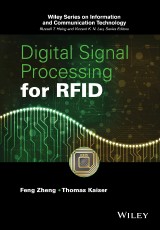Details

Digital Signal Processing for RFID
Information and Communication Technology Series 1. Aufl.
|
89,99 € |
|
| Verlag: | Wiley |
| Format: | |
| Veröffentl.: | 04.03.2016 |
| ISBN/EAN: | 9781118824290 |
| Sprache: | englisch |
| Anzahl Seiten: | 300 |
DRM-geschütztes eBook, Sie benötigen z.B. Adobe Digital Editions und eine Adobe ID zum Lesen.
Beschreibungen
<p>This book discusses the fundamentals of RFID and the state-of-the-art research results in signal processing for RFID, including MIMO, blind source separation, anti-collision, localization, covert RFID and chipless RFID. Aimed at graduate students as well as academic and professional researchers/engineers in RFID technology, it enables readers to become conversant with the latest theory and applications of signal processing for RFID.</p> <p><b>Key Features:</b></p> <ul> <li>Provides a systematic and comprehensive insight into the application of modern signal processing techniques for RFID systems</li> <li>Discusses the operating principles, channel models of RFID, RFID protocols and analog/digital filter design for RFID</li> <li>Explores RFID-oriented modulation schemes and their performance</li> <li>Highlights research fields such as MIMO for RFID, blind signal processing for RFID, anti-collision of multiple RFID tags, localization with RFID, covert RFID and chipless RFID</li> <li>Contains tables, illustrations and design examples</li> </ul>
<p>Preface xi</p> <p>Acknowledgements xiii</p> <p>Abbreviations xv</p> <p><b>1 Introduction 1</b></p> <p>1.1 What is RFID? 1</p> <p>1.2 A Brief History of RFID 2</p> <p>1.3 Motivation and Scope of this Book 2</p> <p>1.4 Notations 5</p> <p>References 5</p> <p><b>2 Fundamentals of RFID Systems 6</b></p> <p>2.1 Operating Principles 6</p> <p>2.2 Passive, Semi-Passive/Semi-Active and Active RFID 8</p> <p>2.3 Analogue Circuits for RFID 10</p> <p>2.4 Circuit Analysis for Signal Transfer in RFID 11</p> <p>2.4.1 Equivalent Circuit of Antennas in Generic Communication Links 12</p> <p>2.4.2 Load Modulation 13</p> <p>2.4.3 Backscattering Modulation 15</p> <p>2.5 Signal Analysis of RFID Systems 17</p> <p>2.5.1 Qualitative Analysis 17</p> <p>2.5.2 Quantitative Analysis 19</p> <p>2.6 Statistical Channel Models 21</p> <p>2.6.1 Backgrounds of Rayleigh, Ricean and Nakagami Fading 21</p> <p>2.6.2 Statistical Channel Models of RFID Systems 26</p> <p>2.6.3 Large Scale Path Loss 27</p> <p>2.7 A Review of RFID Protocol 28</p> <p>2.7.1 Physical Layer 29</p> <p>2.7.2 MAC Layer 32</p> <p>2.8 Challenges in RFID 36</p> <p>2.9 Summary 36</p> <p>Appendix 2.A Modified Bessel Function of the First Kind 37</p> <p>References 38</p> <p><b>3 Basic Signal Processing for RFID 40</b></p> <p>3.1 Bandpass Filters and their Applications to RFID 40</p> <p>3.1.1 Lowpass Filter Performance Specification 40</p> <p>3.1.2 Lowpass Filter Design 42</p> <p>3.1.3 Bandpass Filter Design 47</p> <p>3.1.4 Bandpass Filters for RFID Systems 49</p> <p>3.2 Matching Filters and their Applications to RFID 54</p> <p>3.3 A Review of Optimal Estimation 58</p> <p>3.3.1 Linear Least Square Estimation 58</p> <p>3.3.2 Linear Minimum Mean Square Error Estimation 59</p> <p>3.3.3 Maximum Likelihood Estimation 61</p> <p>3.3.4 Comparison of the Three Estimation Algorithms 62</p> <p>3.4 Summary 64</p> <p>Appendix 3.A Derivation of Poles of the Chebyshev Filter 67</p> <p>References 68</p> <p><b>4 RFID-Oriented Modulation Schemes 69</b></p> <p>4.1 A Brief Review of Analogue Modulation 69</p> <p>4.2 Amplitude- and Phase-Shift Keying and Performance Analysis 72</p> <p>4.2.1 M-ary Quadrature Amplitude Modulation 72</p> <p>4.2.2 Symbol Error Rate Analysis of M-QAM 74</p> <p>4.2.3 Numerical Results for M-QAM 80</p> <p>4.3 Phase-Shift Keying and Performance Analysis 81</p> <p>4.4 Frequency-Shift Keying and Performance Analysis 85</p> <p>4.5 Summary 90</p> <p>Appendix 4.A Derivation of SER Formula (4.24) 91</p> <p>Appendix 4.B Derivation of SER Formula (4.40) 93</p> <p>References 94</p> <p><b>5 MIMO for RFID 95</b></p> <p>5.1 Introduction 95</p> <p>5.2 MIMO Principle 97</p> <p>5.3 Channel Modelling of RFID-MIMO Wireless Systems 100</p> <p>5.4 Design of Reader Transmit Signals 102</p> <p>5.4.1 Signal Design 102</p> <p>5.4.2 Simulation Results 103</p> <p>5.5 Space-Time Coding for RFID-MIMO Systems 105</p> <p>5.5.1 A Review of Real Orthogonal Design 105</p> <p>5.5.2 Space-Time Coding for RFID-MIMO Systems 110</p> <p>5.5.3 Two Space-Time Decoding Approaches for RFID-MIMO Systems 111</p> <p>5.5.4 Simulation Results 113</p> <p>5.6 Differential Space-Time Coding for RFID-MIMO Systems 122</p> <p>5.6.1 A Review of Unitary DSTC 122</p> <p>5.6.2 Application of Unitary DTSC to RFID 125</p> <p>5.6.3 Simulation Results 126</p> <p>5.7 Summary 127</p> <p>Appendix 5.A Alamouti Space-Time Coding for Narrowband Systems 129</p> <p>Appendix 5.B Definition of Group 133</p> <p>Appendix 5.C Complex Matrix/Vector Gaussian Distribution 133</p> <p>Appendix 5.D Maximum Likelihood Receiver for Unitary STC 134</p> <p>References 136</p> <p><b>6 Blind Signal Processing for RFID 138</b></p> <p>6.1 Introduction 138</p> <p>6.2 Channel Model of Multiple-Tag RFID-MIMO Systems 141</p> <p>6.2.1 Channel Model of Single-Tag RFID-MIMO Systems 141</p> <p>6.2.2 Channel Model of Multiple-Tag RFID-MIMO Systems 141</p> <p>6.3 An Analytical Constant Modulus Algorithm 143</p> <p>6.4 Application of ACMA to Multiple-Tag RFID Systems 150</p> <p>6.5 Summary 160</p> <p>References 164</p> <p><b>7 Anti-Collision of Multiple-Tag RFID Systems 166</b></p> <p>7.1 Introduction 166</p> <p>7.2 Tree-Splitting Algorithms 168</p> <p>7.2.1 Mean Identification Delay 171</p> <p>7.2.2 Collision Analysis and Transmission Efficiency: Approach I 173</p> <p>7.2.3 Collision Analysis and Transmission Efficiency: Approach II 175</p> <p>7.2.4 Numerical Results 185</p> <p>7.2.5 Variants of TS Algorithms 194</p> <p>7.3 Aloha-Based Algorithm 194</p> <p>7.3.1 Mean Identification Delay 195</p> <p>7.3.2 Collision Analysis and Transmission Efficiency 197</p> <p>7.3.3 Numerical Results 198</p> <p>7.3.4 Adaptive Frame Size Aloha Algorithms 200</p> <p>7.4 Summary 212</p> <p>Appendix 7.A Inclusion-Exclusion Principle 213</p> <p>Appendix 7.B Probability of Successful Transmissions in Some Particular Time Slots in Aloha 214</p> <p>Appendix 7.C Probability of an Exact Number of Successful Transmissions in Aloha 215</p> <p>References 217</p> <p><b>8 Localization with RFID 220</b></p> <p>8.1 Introduction 220</p> <p>8.2 RFID Localization 223</p> <p>8.2.1 Geometric Class 224</p> <p>8.2.2 Proximity Class 228</p> <p>8.3 RFID Ranging – Frequency-Domain PDoA Approach 232</p> <p>8.4 RFID AoA Finding – Spatial-Domain PDoA 235</p> <p>8.5 NLoS Issue 241</p> <p>8.6 Summary 244</p> <p>References 245</p> <p><b>9 Some Future Perspectives for RFID 249</b></p>
<strong>Dr Feng Zheng, University of Duisburg-Essen, Germany</strong><br />Feng Zheng received his Ph.D. degree from Beijing University of Aeronautics and Astronautics in 1993. He held an Alexander-von-Humboldt Research Fellowship at University of Duisburg and was an Associate Professor in Chinese Academy of Sciences. <p><strong>Dr Thomas Kaiser, University of Duisburg-Essen, Germany</strong><br />Thomas Kaiser received the Ph.D. degree in 1995 with distinction and the German habilitation degree in 2000, both from Gerhard-Mercator-University, Duisburg, and in electrical engineering.
Diese Produkte könnten Sie auch interessieren:

Strategies to the Prediction, Mitigation and Management of Product Obsolescence

von: Bjoern Bartels, Ulrich Ermel, Peter Sandborn, Michael G. Pecht

116,99 €
















